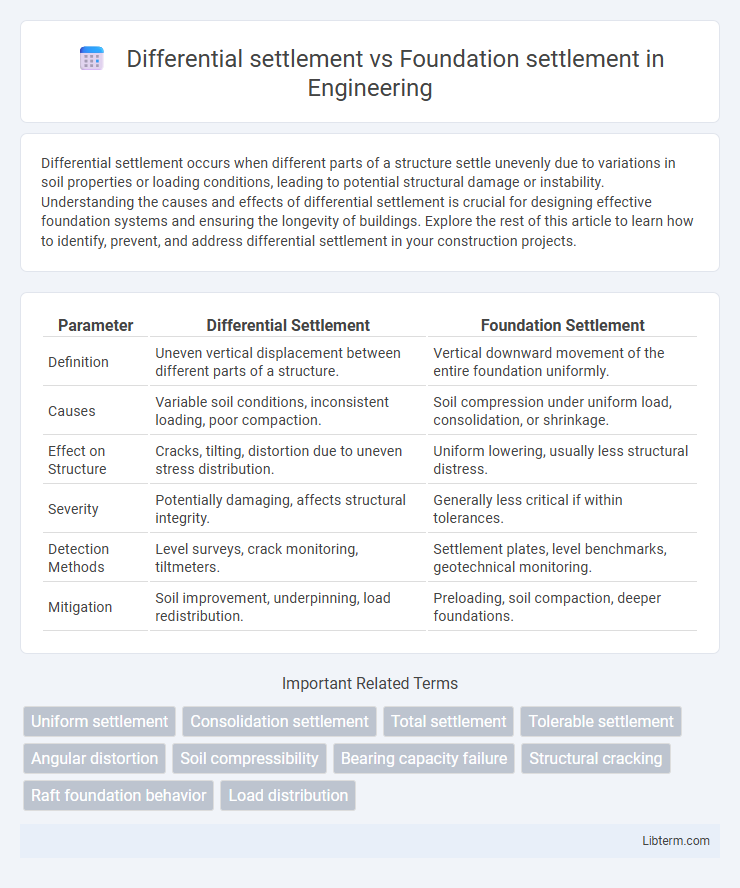Differential settlement occurs when different parts of a structure settle unevenly due to variations in soil properties or loading conditions, leading to potential structural damage or instability. Understanding the causes and effects of differential settlement is crucial for designing effective foundation systems and ensuring the longevity of buildings. Explore the rest of this article to learn how to identify, prevent, and address differential settlement in your construction projects.
Table of Comparison
| Parameter | Differential Settlement | Foundation Settlement |
|---|---|---|
| Definition | Uneven vertical displacement between different parts of a structure. | Vertical downward movement of the entire foundation uniformly. |
| Causes | Variable soil conditions, inconsistent loading, poor compaction. | Soil compression under uniform load, consolidation, or shrinkage. |
| Effect on Structure | Cracks, tilting, distortion due to uneven stress distribution. | Uniform lowering, usually less structural distress. |
| Severity | Potentially damaging, affects structural integrity. | Generally less critical if within tolerances. |
| Detection Methods | Level surveys, crack monitoring, tiltmeters. | Settlement plates, level benchmarks, geotechnical monitoring. |
| Mitigation | Soil improvement, underpinning, load redistribution. | Preloading, soil compaction, deeper foundations. |
Introduction to Settlement in Construction
Settlement in construction refers to the downward movement of a structure due to soil compression under load, impacting structural integrity. Differential settlement occurs when parts of a foundation settle unevenly, causing tilting, cracking, or structural damage, often due to varying soil conditions or load distribution. Understanding and mitigating both uniform foundation settlement and differential settlement are critical to ensuring building stability and longevity.
Understanding Foundation Settlement
Foundation settlement refers to the vertical movement of a building's foundation due to soil compression under load. Differential settlement occurs when different parts of the foundation settle unevenly, causing structural stress and potential damage. Understanding foundation settlement is critical for designing foundations that minimize uneven displacement and maintain structural integrity.
What is Differential Settlement?
Differential settlement occurs when different parts of a structure's foundation settle unevenly due to variations in soil composition, load distribution, or moisture levels. This uneven settling can cause structural stress, cracks, and misalignment, posing a significant risk to building stability. Understanding differential settlement is crucial for foundation engineering to design appropriate mitigation measures and ensure long-term structural integrity.
Causes of Foundation Settlement
Foundation settlement primarily occurs due to soil consolidation under structural loads, soil shrinkage from moisture loss, or inadequate compaction during construction. Variations in soil composition, such as the presence of expansive clays or compressible organic layers, can exacerbate settlement. Water table fluctuations and poor drainage further contribute to uneven load distribution, increasing the risk of foundation settlement.
Factors Leading to Differential Settlement
Differential settlement occurs when different parts of a foundation settle unevenly due to variations in soil composition, moisture content, and load distribution, leading to structural damage. Soil heterogeneity, changes in groundwater levels, and the presence of compressible layers such as clay or organic material significantly contribute to differential settlement. Unequal load imposed by varying building weights and poor construction practices intensify the risk of differential settlement compared to uniform foundation settlement.
Signs and Symptoms of Foundation Settlement
Foundation settlement often manifests through visible signs such as cracked walls, uneven floors, and sticking doors or windows, which indicate structural movement. Differential settlement, a type of foundation settlement, causes uneven sinking of different parts of a structure, leading to more pronounced issues like diagonal cracks and misaligned foundations. Early detection of these symptoms is crucial to prevent costly repairs and maintain building integrity.
Risks Associated with Differential Settlement
Differential settlement occurs when different parts of a building's foundation settle unevenly, causing structural stress, cracks, and potential failure in walls, floors, and roofs. This uneven movement leads to risks such as misaligned doors and windows, compromised load distribution, and increased vulnerability to seismic activity. Identifying and mitigating differential settlement early is critical to preventing costly repairs and ensuring long-term structural integrity.
Methods of Preventing Settlement Issues
To prevent differential settlement and foundation settlement issues, engineers implement soil stabilization techniques such as compaction grouting and deep soil mixing to enhance ground bearing capacity. Use of deep foundations like piles or drilled shafts transfers loads to more stable soil layers or bedrock, minimizing uneven settlement risks. Proper site investigation and selection of appropriate foundation types based on soil conditions are crucial for effective settlement control and structural stability.
Remediation Techniques for Settlement Problems
Differential settlement occurs when different parts of a structure settle unevenly, causing stress and potential damage, while foundation settlement refers to the overall lowering of the foundation due to soil compression. Remediation techniques for settlement problems include underpinning methods such as piering or piling to stabilize and lift the foundation, grout injection to fill voids and improve soil bearing capacity, and soil stabilization through compaction or chemical additives to reduce further settlement risks. Employing these targeted solutions helps restore structural integrity and mitigate ongoing foundation movement.
Conclusion: Differential vs Foundation Settlement
Differential settlement refers to the uneven sinking of different parts of a structure's foundation, causing stress and potential damage, whereas foundation settlement is the uniform downward movement of the entire foundation. Understanding the distinction is crucial for effective structural design and remediation strategies, as differential settlement often leads to more severe structural problems compared to uniform foundation settlement. Proper soil analysis and foundation engineering can mitigate risks associated with both differential and overall foundation settlement.
Differential settlement Infographic

 libterm.com
libterm.com